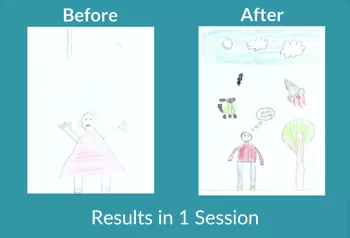Primitive Reflex Integration Case Studies
10-Year-Old Improves Drawing with One Session of Integrated Movement
Reflex integration results in fine motor gains
This OT used tools from the Brain and Sensory Foundations course to help her son who had fine motor challenges, including a poor pencil grasp. After just one reflex integration session using the 5-Step-Balance, he was more relaxed while drawing, showed improved accuracy, and enjoyed adding extra details to his picture.
Submitted by Ellen Winney, Occupational Therapist

| Before | After |
|---|---|
| Drawing skills below expectations for age | Improved and more confident drawing skills |
| 3/4 on 5-Point scale for both Grasp and Palmar reflexes | Palmar and Grasp reflexes are now at a 2 out 5 |
Luke is ten-year-old boy with a history of difficulty with handwriting and pencil grasp. Despite this OT being his mother and homeschooling teacher and addressing these issues through the years, and as well as one of my colleagues working with him on his fine motor and handwriting skills, he continues to hold writing instruments with a lateral grasp. His has difficulty with legibility unless he writes extremely slowly, although cursive tends to be slightly better than print. Although he likes doing origami, including designing and decorating his own creations, his drawing skills are below what would be expected for his age.
In initially testing his reflexes, on the 5-point scale he scored a 2 on TLR [Tonic Labyrinthine Reflex], 2/3 on ATNR [Asymmetrical Tonic Neck Reflex], and a 3/4 on both Grasp and Palmer reflexes. He also scored a 1 on Plantar and Babinski reflexes. We began with a week of daily rhythmic movement exercises and then in the second week added daily isometrics and activities to address the TLR, ATNR, Grasp and Palmar reflexes. Luke enjoyed all the activities and showed great improvement in moving from passive to active movement for the rhythmic movements.
At the end of the second week of daily treatment, Luke had an assignment for school that involved having to draw a person. He began to show signs of stress and attempts to get out of the assignment.
I decided this to be the perfect opportunity to engage the 5-Step Balance Process [from the Brain and Sensory Foundations program]. With minimal coaching, he was able to state the goal “I am drawing a person easily and correctly.” He initially drew a picture of a girl, showing signs of discomfort (wiggling, lack of focus, disparaging remarks about his drawing). I then stimulated the ATNR, Palmar, and Grasp reflexes as these are the ones most involved in fine motor and visual motor skills. He then engaged in his daily rhythmic movement activities and isometric exercises for the above mentioned reflexes. We then completed the Support Re-patterning Sequence, ending with hook ups. He then drew a second person. This time he was visibly much more relaxed and even asked if he could continue the drawing by adding more detail. The remarkable before and after results are shown below. I especially love how in the second drawing, he drew a word bubble with the boy saying, “What a nice day”. Any skepticism I had about the 5-Step Balance Process disappeared seeing these drawings! When asked about the experience Luke stated, “The second time I felt more confident that I could do it. I think my boy is way better than my girl.” The speech bubble says, "What a nice day!"
Additionally, in retesting after two weeks of treatment, his Palmar and Grasp reflexes are now at a 2 out 5! My biggest regret is that I did not know this information about the treatment of retained reflexes several years ago. If I had, I would have approached his fine motor and handwriting skills completely differently, which I’m sure would have caused much less stress and frustration for both of us. We will be continuing to use the rhythmic movements, isometric exercises, and other therapeutic activities daily and I am excited to see where his fine motor, visual motor, and handwriting skills will be a few months from now. Additionally, when he is facing challenging situations in the future, we will be using the 5-Step Balance Process to decrease stress and maximize success.
[Edited for length and clarity; emphasis added]
*Disclaimer: The activities in the Brain and Sensory Foundations curriculum make use of the natural processes of neuroplasticity and development that are innately wired in the design of human beings to promote maturity and function. These activities appear to calm, organize, and mature the neuro-sensory-motor systems just as we see in the healthy development of human infants. Individual results may vary, and we do not claim to offer a diagnosis or cure for any specific condition or disorder. The Brain and Sensory Foundations activities appear to improve overall functioning resulting in measurable improvements for a range of conditions as demonstrated in over 1800 case studies from participants.

